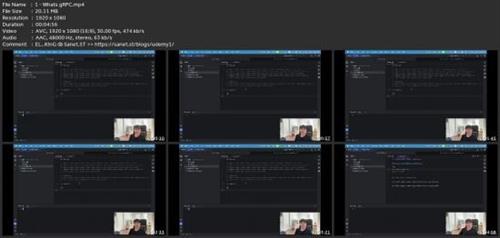- Thread Starter
- #1
Grpc For Microservice Environments

Microservice architecture requires more performant ways to communicate to each other. gRPC helps you to achieve this.
What you'll learn
gRPC communication in Microservice environment
Protocol Buffers
How to use gRPC in a Hexagonal Architecture
Resiliency patterns in gRPC
Requirements
Knowing the ways while communicating with an API, like aware of RESTful Api's and some knowledge.
Description
This course is designed to help you understand and apply gRPC, an efficient and modern RPC (Remote Procedure Call) framework, to improve communication in microservices architectures. Whether you're new to gRPC or looking to enhance your skills, this course provides a clear and hands-on approach to learning how gRPC works and how it can transform your system's performance.We'll begin by covering the fundamental concepts behind gRPC, including Protocol Buffers (protobufs), the serialization mechanism that powers gRPC's high performance. You'll learn how gRPC compares to REST and why it's often the better choice for service-to-service communication in modern, distributed systems.The course then moves on to practical implementations of gRPC. You'll learn how to set up and use gRPC to build faster, more scalable, and reliable microservices. Along the way, we'll focus on how gRPC can simplify communication between services and reduce overhead, all while maintaining the flexibility and speed necessary for high-performance systems.By the end of this course, you'll have the skills needed to implement gRPC in your own systems and take advantage of its powerful features to improve the efficiency and maintainability of your microservices. Whether you're working on new projects or optimizing existing ones, this course will give you the knowledge to leverage gRPC effectively.Ideal for developers and engineers, this course will help you optimize backend systems by improving communication, performance, and scalability using gRPC.
Overview
Section 1: Introduction
Lecture 1 What's gRPC
Lecture 2 Practical example with Order Service
Lecture 3 Protocol Buffer Encoding
Section 2: Resiliency Patterns
Lecture 4 Intro
Lecture 5 Timeout Pattern
Lecture 6 Timeout Pattern Discount Service
Lecture 7 Timeout Pattern Demo
Section 3: Hexagonal Architecture and gRPC
Lecture 8 What's Hexagonal Architecture
Lecture 9 Hexagonal Architecture with Rest Api
Lecture 10 gRPC implementation
Engineers who wants to learn more about Microservices,Looking more performing ways for inter service communcation beside of Rest APIs,Developers and Devops or anyone wants to be one.

rapidgator.net:
nitroflare.com:

Published 9/2024
MP4 | Video: h264, 1920x1080 | Audio: AAC, 44.1 KHz
Language: English | Size: 439.35 MB | Duration: 1h 4m
MP4 | Video: h264, 1920x1080 | Audio: AAC, 44.1 KHz
Language: English | Size: 439.35 MB | Duration: 1h 4m
Microservice architecture requires more performant ways to communicate to each other. gRPC helps you to achieve this.
What you'll learn
gRPC communication in Microservice environment
Protocol Buffers
How to use gRPC in a Hexagonal Architecture
Resiliency patterns in gRPC
Requirements
Knowing the ways while communicating with an API, like aware of RESTful Api's and some knowledge.
Description
This course is designed to help you understand and apply gRPC, an efficient and modern RPC (Remote Procedure Call) framework, to improve communication in microservices architectures. Whether you're new to gRPC or looking to enhance your skills, this course provides a clear and hands-on approach to learning how gRPC works and how it can transform your system's performance.We'll begin by covering the fundamental concepts behind gRPC, including Protocol Buffers (protobufs), the serialization mechanism that powers gRPC's high performance. You'll learn how gRPC compares to REST and why it's often the better choice for service-to-service communication in modern, distributed systems.The course then moves on to practical implementations of gRPC. You'll learn how to set up and use gRPC to build faster, more scalable, and reliable microservices. Along the way, we'll focus on how gRPC can simplify communication between services and reduce overhead, all while maintaining the flexibility and speed necessary for high-performance systems.By the end of this course, you'll have the skills needed to implement gRPC in your own systems and take advantage of its powerful features to improve the efficiency and maintainability of your microservices. Whether you're working on new projects or optimizing existing ones, this course will give you the knowledge to leverage gRPC effectively.Ideal for developers and engineers, this course will help you optimize backend systems by improving communication, performance, and scalability using gRPC.
Overview
Section 1: Introduction
Lecture 1 What's gRPC
Lecture 2 Practical example with Order Service
Lecture 3 Protocol Buffer Encoding
Section 2: Resiliency Patterns
Lecture 4 Intro
Lecture 5 Timeout Pattern
Lecture 6 Timeout Pattern Discount Service
Lecture 7 Timeout Pattern Demo
Section 3: Hexagonal Architecture and gRPC
Lecture 8 What's Hexagonal Architecture
Lecture 9 Hexagonal Architecture with Rest Api
Lecture 10 gRPC implementation
Engineers who wants to learn more about Microservices,Looking more performing ways for inter service communcation beside of Rest APIs,Developers and Devops or anyone wants to be one.
Screenshots

rapidgator.net:
You must reply in thread to view hidden text.
nitroflare.com:
You must reply in thread to view hidden text.
